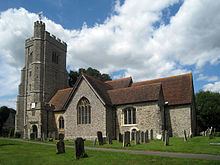OS grid reference TQ953494 Local time Friday 5:11 AM Dialling code 01233 | Sovereign state United Kingdom Area 24.9 km² District Borough of Ashford | |
 | ||
Population 2,766 (Civil Parish 2011) Weather 6°C, Wind SE at 14 km/h, 86% Humidity | ||
Charing cross history of london sightseeing place name origins
Charing is a mostly agricultural large village and civil parish in the Ashford District of Kent, in south-east England.; it includes the settlements of Charing Heath and Westwell Leacon. It is at the foot of the North Downs and reaches up to the escarpment.
Contents
- Charing cross history of london sightseeing place name origins
- Map of Charing UK
- History
- Mills
- Places of interest
- Amenities
- Community
- Demography
- Transport
- References
Map of Charing, UK
The Pilgrims' Way the M20 motorway and Charing railway station (between London Victoria and Ashford International via Maidstone) serve the parish.
History
The name Charing first appears in 799 as Ciorrincg. The name probably comes from the Anglo-Saxon word cerring, which means a bend in the road, or it may be from Ceorra-ingas, which is Anglo-Saxon, meaning people of Ceorra. The village is sited on the Pilgrims' Way from London to Canterbury, and is one day's walk from Canterbury. There are a number of old manors located around the village, such as Newlands (now a horse stud) and Pett Place. The village had a market recorded in 1285, and a fair recorded in the fifteenth century.
Church of St Peter and St Paul, the parish church of Charing, is situated next to the remains of the Archbishop's Palace, just off the High Street. The church's west tower was built in the 14th century, though most of the rest of the building was reconstructed following a catastrophic fire in the 16th century. The church contains a number of memorials to the Dering family, a branch of the Dering family of Surrenden Dering, Pluckley, Kent.
Mills
Charing has had four mills over the centuries, serving the needs of the villagers. There were two watermills on the Upper Great Stour and two windmills.
Places of interest
Its most famous building is the Archbishop's Palace, which lies by the church and was an ancient possession of the Archbishop of Canterbury. The palace was an important building in the diocese of Canterbury, and counted amongst its guests King Henry VIII. It has been a farmhouse for the last 300 years. In 2004, the palace was an unsuccessful contestant in the BBC television programme Restoration, where a number of potential restoration projects throughout the UK competed for funds. The church is said to contain the stone on which John the Baptist was beheaded.
Amenities
These include:
The Swan on the hilltop outskirts; includes restaurant.
Community
Housing development since the 1960s has also led to a significant proportion of people employed in London or business parks on the motorway corridors. Groups of residents organise frequent club-based or charity events and fairs. Charing has in the same period revived its Youth Club and cricket team/facilities. There is also a bowls club. A skate park has been added. A Community Warden assists the youths.
Demography
At the 2001 UK census, the Charing electoral ward had a population of 2,284. The ethnicity was 98% white, 0.7% mixed race, 0.6% Asian, 0.3% black and 0.4% other. The place of birth of residents was 95.7% United Kingdom, 0.5% Republic of Ireland, 1.2% other Western European countries, and 2.6% elsewhere. Religion was recorded as 77.4% Christian, 0.3% Buddhist, 0% Hindu, 0% Sikh and 0.2% Jewish, 0.4% Muslim. 12.6% were recorded as having no religion, 0.2% had an alternative religion and 8.8% did not state their religion.
The economic activity of residents aged 16–74 was 32% in full-time employment, 11.9% in part-time employment, 14.3% self-employed, 2.2% unemployed, 1.9% students with jobs, 2.1% students without jobs, 20.5% retired, 7.1% looking after home or family, 4.6% permanently sick or disabled and 3.5% economically inactive for other reasons. The industry of employment of residents was 17.8% retail, 12.9% manufacturing, 8.2% construction, 14.7% real estate, 10.2% health and social work, 7.4% education, 5% transport and communications, 4.1% public administration, 5.1% hotels and restaurants, 4.4% finance, 4.4% agriculture and 5.8% other. Compared with national figures, the ward had a relatively high proportion of workers in agriculture and construction. There were a relatively low proportion in public administration, transport and communications. Of the ward's residents aged 16–74, 18.4% had a higher education qualification or the equivalent, compared with 19.9% nationwide.
Transport
Transport links provided by the A20 London to Dover road, and direct train services to Ashford International and London Victoria via Maidstone East.
Train services are operated by Southeastern, with one train in each direction throughout the middle hours of the day, and an much enhanced service during the morning and evening peak periods.
Charing railway station was opened on 1 July 1884, as part of the London, Chatham and Dover Railway (LCDR) extension to Ashford West of the 1874 line to Maidstone, which itself was a branch off the LCDR's Sevenoaks branch of 1862, which joined the LCDR mainline of 1840 at Swanley. In the wake of 1955 British Rail Modernisation plan, the "Kent Coast Electrification" scheme saw the suburban electrification of the previous Southern Railway extended from Maidstone East through to Ashford.
